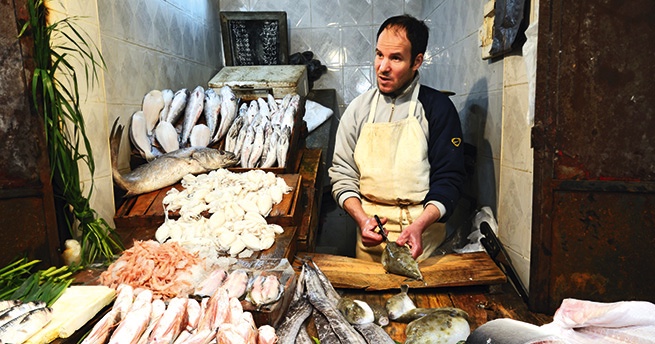
Ahmed, my guide who grew up in Fez el-Bali, meets me after my breakfast. “Don’t judge a book by its cover,” he tells me, disappearing like the white rabbit in Alice in Wonderland into the narrowest of alleyways.
On the elegant roof terrace of Riad Fès, in the Moroccan city of Fez, I settle down on a sofa for a swift’s-eye view of the sun setting the Middle Atlas Mountains ablaze. Below, Fez el-Bali (the 9th-century medina) turns golden in the afterglow. I spread out my map and laugh at the notion of trying to navigate this puzzle of some 9,000 narrow streets without a guide.
Riad Fès has been called the sexiest hotel in town, but in a city where modesty is de rigueur, “sensual” is more appropriate. Think aromas of mint, orange blossom and cumin, the taste of roasted almonds, the morning call to prayer. My suite is furnished in rich earthy tones and tactile fabrics and sprinkled with objets d’art. There are leather-bound books on the shelf, scented candles to light and a silk throw to wrap up in. The hotel centrepiece is a tiled courtyard with antique sculpted doors, Islamic carvings, stained glass windows and an immense Moorish chandelier. No sweaty package tourists here, just arty looking travellers in cool white linen sipping mint tea and flicking through their guidebooks. There’s also a pool set against a wall of ferns, which is big enough to swim in – essential if you’re visiting during the hottest months of July-August – and an exquisitely tiled Moroccan spa, complete with hammam.
Ahmed, my guide who grew up in Fez el-Bali, meets me after my breakfast of sweet almond pastries. “Don’t judge a book by its cover,” he tells me, disappearing like the white rabbit in Alice in Wonderland into the narrowest of alleyways. Behind many doors in these simple streets are beautiful houses. Occasionally we get a glimpse into these worlds –an orange tree-filled courtyard, burbling fountain or palm-shaded terrace. Elsewhere, time stands still. A knife grinder turns his stone wheel. A spoon is carved from cedar wood. A bobbin shuttles across a loom. Yarn is dyed in Souk Sabbaghine, the Dyers’ Souk, where rainbow streams run to the river. I’m introduced to Ahmed’s friend, Nizar, 84, who carves combs, necklaces and trinkets from cow horn in the same hole-in-the-wall workshop he’s had since 1952. “You are welcome,” he says with a three-toothed grin.
Fishmonger
We lunch on smoked-aubergine pâté with lemon jam, followed by saffron tajine with artichoke and chickpeas at the Ruined Garden Restaurant in the charming Riad Idrissy, an advocate of the “slow food” movement, which protects the taste and variety of local food. They also run al fresco bread- and couscous-making courses in their lovely flower-filled garden.
Beyond the medina there are other faces to Fez: Ville Nouvelle, the “modern town” with its palm-lined boulevards, designer shops and French restaurants, and Fez el-Jedid, a continuation of the medina, but not quite as chaotic or ancient, dating from 1276. But it’s Fez el-Bali, possibly the largest urban car-free zone in the world that I can’t wait to explore more of.
Tourists aren’t usually allowed to wander into the Al-Karaouine University, the oldest in the world, (859). However, I was lucky, the immense wooden doors of the main entrance were ajar and I could peek through a series of horseshoe arches, decorated in geometrical and floral art and bordered with Kufic calligraphy, to a tiled courtyard and marble fountains.
I tell Ahmed I’m in the market for a soft lambskin jacket. “The smell is for free, but the leather is not,” he jokes, as we arrive at the tanneries in Chouwara, arguably the most medieval sight in the medina, a vast honeycomb of vats used for treating and dying the animal skins. A shopkeeper offers a sprig of mint to hold to my nose, as the smell of ammonia from the cauldrons of pigeon dung used to soften the animal hides is extremely pungent. We haggle over the price of a leather jacket the colour of lapis lazuli, although I know I’ve paid too much when he throws in a free wallet!
Chouwara Tannery / Kate Wickers
Dinner is under the citrus trees in the courtyard restaurant of the restored 1930s art deco Palais Amani. The food here is renowned, so I choose the chef’s special: creamy avocado mousse, a beef tajine that flakes off the bone on to a bed of artichokes, and semifreddo orange tart. It’s a contemplative spot, and sipping a cool Casablanca beer I muse that however hard foreign investors scrub at Fez’s medieval grime, this is a city that will never forget what it is – the cultural and intellectual heart of Morocco. Meanwhile, Ahmed, Nizar and the other 156,000 people who live in Fez el-Bali simply call it home.
Latest Articles
Don't miss the latest from Luxury Travel
